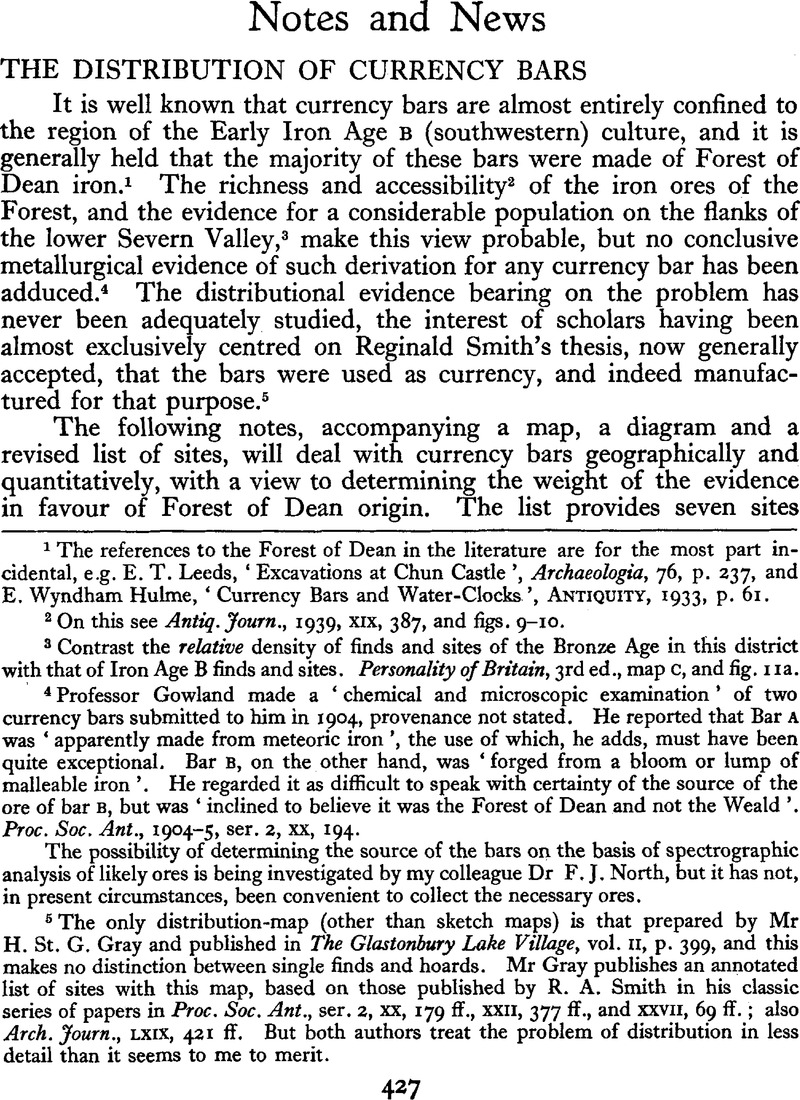Article contents
Notes and News
Published online by Cambridge University Press: 02 January 2015
Abstract

- Type
- Notes and News
- Information
- Copyright
- Copyright © Antiquity Publications Ltd 1940
References
1 The references to the Forest of Dean in the literature are for the most part incidental, e.g. E. T. Leeds, ‘Excavations at Chun Castle’, Archaeologia, 76, p. 237, and E. Wyndham Hulme, ‘Currency Bars and Water-Clocks.’, ANTIQUITY, 1933, p. 61.
2 On this see Antiq. Journ., 1939, XIX, 387, and figs. 9-10.
3 Contrast the relative density of finds and sites of the Bronze Age in this district with that of Iron Age B finds and sites. Personality of Britain, 3rd ed., map C, and fig. 11a.
4 Professor Gowland made a ‘chemical and microscopic examination’ of two currency bars submitted to him in 1904, provenance not stated. He reported that Bar A was ‘apparently made from meteoric iron’, the use of which, he adds, must have been quite exceptional. Bar B, on the other hand, was ‘forged from a bloom or lump of malleable iron’. He regarded it as difficult to speak with certainty of the source of the ore of bar B, but was ‘inclined to believe it was the Forest of Dean and not the Weald’. Proc. Soc. Ant., 1904-5, ser. 2, XX, 194.
The possibility of determining the source of the bars on the basis of spectrographic analysis of likely ores is being investigated by my colleague Dr F.J. North, but it has not, in present circumstances, been convenient to collect the necessary ores.
5 The only distribution-map (other than sketch maps) is that prepared by Mr H. St. G. Gray and published in The Glastonbury Lake Village, vol. II, p. 399, and this makes no distinction between single finds and hoards. Mr Gray publishes an annotated list of sites with this map, based on those published by R. A. Smith in his classic series of papers in Proc. Soc. Ant., ser. 2, XX, 179 ff., XXII, 377 ff., and XXVII, 69 ff. ; also Arch. Journ., LXIX, 421 ff. But both authors treat the problem of distribution in less detail than it seems to me to merit.
6 Miss L. F. Chitty, F.S.A., Mrs E. M. Clifford, and Mrs B. H. St. J. O’Neil, have kindly helped me with these additions and modification.
7 J. P. Bushe-Fox, Hengistbury, Research Rep. Soc. Ant., 1915, no. III, pp. 8-10.
8 See a recent geological map of the Forest of Dean, published in Antiq. Journ., 1939, XIX, p. 388, fig. 9.
* This work was compiled in 1684, completed in 1692, but not printed till 1823. It may be found in the appendix to the second volume of Mackenzie’s History of Galloway, and in the Geographical Collections relating to Scotland made by Walter Macfarlane, published by the Scottish Historical Society. The extract here given is as quoted by Rev. C. H. Dick in Highways and Byways in Galloway and Carrick (edn. 1919), p. 294.
10 For a recent review of the nature and origin of flint see Dr K. P. Oakley’s paper in Science Progress, XXXIV (Oct. 1939), 277.
11 And also incrustations, insoluble in hydrochloric acid, and therefore probably consisting of calcium silicate.
- 1
- Cited by


